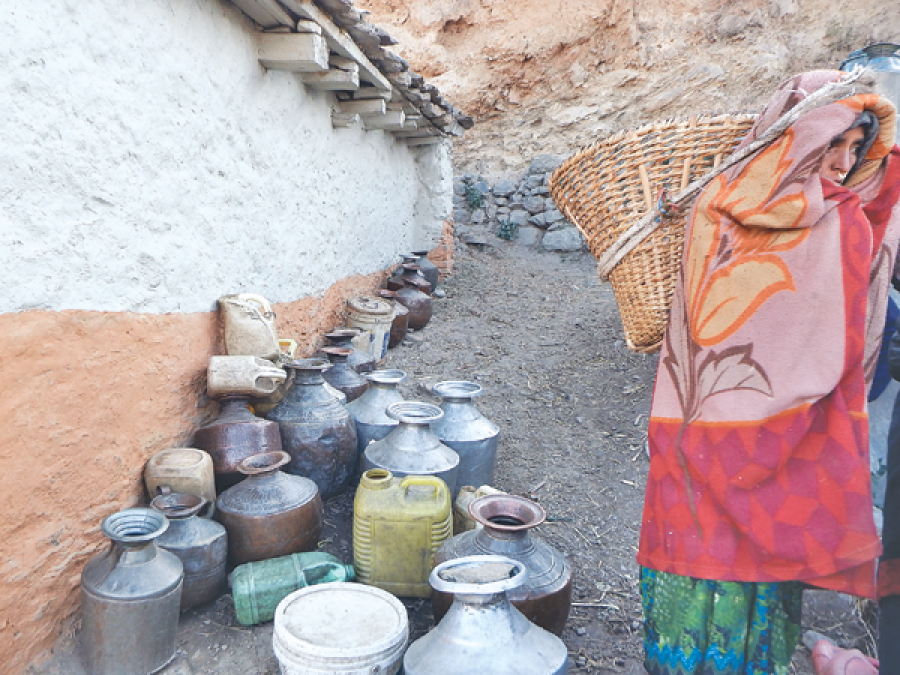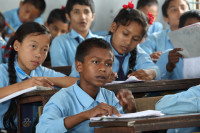Opinion
Drying of the west
This year’s drought in Karnali is more a policy disaster than a natural one
Samrat Katwal & Maya Lal Mahatara
As we enter Mahila village in Humla, a child of around 12, sitting at the entrance, looks at us and in a serious tone, says, “You saw the crops. There has been a massive drought this year.”
The child was repeating what he had been hearing from his family. People in the Karnali region have been discussing the imminent food insecurity for a while now. Everywhere we went, people grumbled about the produce this year. Even as far back as in October, they were saying that the crop was not worth harvesting. In December as we walked through Kalikot, we saw the locals of Dhaulagaha VDC leaving for India after their winter crop, in particular wheat, failed to mature because of a delayed snowfall. They were saying that they would have to stay a few months longer labouring in India this year because of the drought. The elderly say that this year’s drought is the worst they have faced in the last 30 years. There has been no rain since the middle of July and the percentage of monsoon harvest has dropped by more than half. The delayed snowfall and the subsequent loss of winter crop made things worse.
Like the earthquake that damaged houses in April, this drought has shaken the core of Karnali. Unfortunately, it is a calamity taking place far from Kathmandu—a calamity that did not knock down Dharahara, and is hence unrecognised. There is nothing more devastating to a farmer than to lose the crops that sustain their family. Other effects of the drought can already be seen in families and communities. Fights over access to drinking water have sprung. In villages where springs have dried up, young girls spend additional hours fetching water. The only way out of this problem for the residents of Karnali is to increase the number of months of seasonal migration to India. The drought has already taken many young boys out of school and into the labour markets of India. Disconcertingly, seasonal migration is a privilege accorded to those families with able-bodied sons. The old, physically weak, single women and the ultra-poor who cannot gather cash to travel to India will suffer the most.
The big problem
We cannot blame the rain gods anymore, as Karnali has always been an arid region, despite which civilisations have flourished. The Karnali drought is less about water scarcity than about the dearth of vision in leaders and national policies. Three decades ago, when the then great drought struck the region, the Nepal government and humanitarian organisations started flying in rice and never stopped. Now, more rice will be dropped in response, preserving the synonym that the Karnali region has come to be recognised as: underdevelopment. Dropping more sacks of rice might provide immediate relief, but it will not solve the problem.
The problem is that the government has always treated the people of Karnali as inferior Nepalis. It has never cared to recognise that food insecurity in Karnali can only be solved by adjusting policies to suit the regions’ geography. As a result, vast terraces that once produced ample cotton and drought resilient grains like quinoa, amaranth and sorghum are now left barren. While Uttarakhand—a state in India bordering Karnali in the west—exported 200 tonnes of amaranth to the US last year, Karnali planted maize—a crop heavily promoted all over by the Nepal government. The drought hit the corn the hardest.
Appropriate policy
The Karnali region has to be recognised as arid, but not sterile. The wild walnut trees on the trail from Humla to Mugu, the wild olive forests in Kalikot, the hills covered in aloe vera shrubs, and the cliffs sprouting blue agave (plants that the Mexicans use to produce costly takila) all bear witness to the fact that the alpine desert is a rare treasure. It can produce what few places on Earth can effectively produce. But to make it a reality, our policies and programmes have to accommodate the demands of Karnali’s geography.
The government has to invest in snow ponds and snow harvesting as a means of irrigation and not rely solely on river canals. It has to understand that flat land is scarce in the mountains, but that vast opportunities exist on the hills and steep slopes, where valuables like olive, aloe vera, nuts, apples, fig, pomegranate and gooseberry are already flourishing in the wild. Our policy makers must realise that staple crops like quinoa, amaranth and sorghum are healthier and more Karnali-friendly than rice or maize.
This year’s drought is more a policy disaster than a natural one. Flying in rice to solve this drought can be a short-term intervention if it comes with a clear exit strategy. But if we are to learn from mistakes, our policy makers need to first remind themselves that Nepal’s geography is diverse and then turn that realisation into policies and programmes. Fruits will bloom again in Karnali only if Singh Durbar and its policies are Karnali-friendly. Until then, the saga of drought will continue.
Katwal is a development practitioner; Mahatara is associated with Karnali Agriculture and Food Concern Group




 8.12°C Kathmandu
8.12°C Kathmandu










